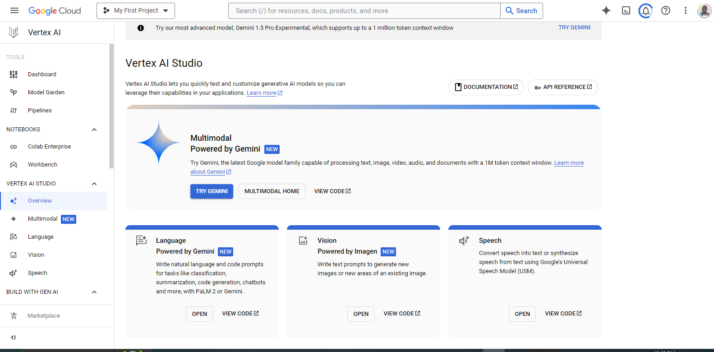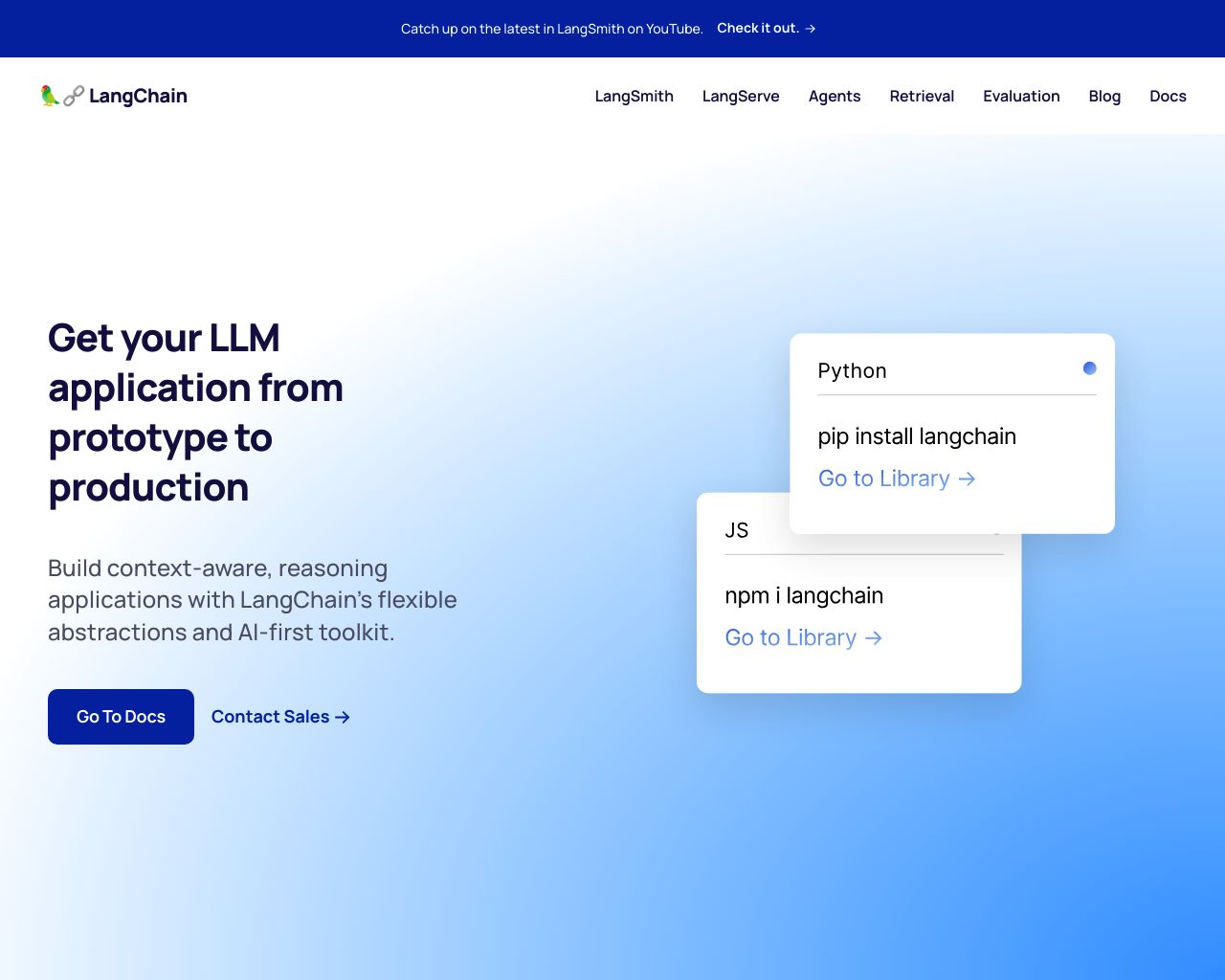AI development platforms have become essential tools for businesses and developers seeking to harness the power of machine learning and natural language processing. This comparison explores two leading solutions: Google’s Vertex AI and the open-source LangChain framework. Vertex AI offers a comprehensive, cloud-based machine learning platform with robust MLOps capabilities, while LangChain provides a flexible framework for building language model applications. We’ll examine their key features, strengths, and limitations to help you determine which platform best suits your AI development needs. Additionally, we’ll introduce SmythOS, an innovative alternative that combines user-friendly design with powerful AI capabilities, potentially offering the best of both worlds for many users.
Vertex AI Overview
Vertex AI delivers a comprehensive machine learning platform for training and deploying AI models at scale. Google’s platform integrates powerful tools for data preparation, model development, and production deployment, streamlining the entire AI lifecycle.
Vertex AI caters to data scientists and ML engineers seeking to build enterprise-grade AI solutions. The platform excels at handling complex machine learning workflows, from data ingestion to model serving. Its standout features include AutoML for automated model creation, custom model support for flexibility, and robust MLOps capabilities for managing models in production.

Screenshot from Vertex AI studio.
Vertex AI caters to data scientists and ML engineers seeking to build enterprise-grade AI solutions. The platform excels at handling complex machine learning workflows, from data ingestion to model serving.
Key strengths of Vertex AI include seamless integration with Google Cloud services, support for popular ML frameworks, and access to cutting-edge models like Gemini. The platform’s unified interface simplifies collaboration between data scientists, engineers, and business teams. However, Vertex AI’s power comes with a learning curve – users need solid ML knowledge to leverage its full potential.
Vertex AI shines in its ability to handle massive datasets and scale effortlessly. The platform’s managed infrastructure removes operational burdens, allowing teams to focus on model development. While not the most beginner-friendly option, Vertex AI’s comprehensive toolset and integration capabilities make it a compelling choice for organizations building sophisticated AI applications.
LangChain Overview
LangChain revolutionizes AI application development by providing an open-source framework for creating large language model (LLM) powered solutions. LangChain simplifies the entire LLM application lifecycle, from development to deployment, with robust tools and components.

The platform offers a comprehensive suite of libraries and tools, including LangChain Expression Language (LCEL) for declarative component chaining, LangGraph for building stateful multi-actor applications, and LangSmith for debugging and monitoring. These features empower developers to create sophisticated AI agents capable of understanding context, solving complex problems, and interacting naturally with users.
LangChain revolutionizes AI application development by providing an open-source framework for creating large language model (LLM) powered solutions.
LangChain’s modular approach allows seamless integration with third-party tools and data sources, making it a versatile choice for various industries. The framework supports multimodal inputs, enabling developers to create AI applications that process text, images, audio, and video. This flexibility, combined with robust documentation and community support, positions LangChain as a powerful tool for both seasoned developers and those new to AI development.
While LangChain offers extensive capabilities, it requires coding knowledge, which may present a learning curve for non-technical users. The platform’s open-source nature means that users must manage their own infrastructure and scaling, potentially increasing complexity for large-scale deployments. Despite these challenges, LangChain’s comprehensive toolkit and active development community make it a compelling choice for those seeking to harness the full potential of LLMs in their applications.
Feature Comparison
Vertex AI and LangChain offer distinct approaches to AI development, with key differences in their core components and security features. Vertex AI provides a comprehensive, cloud-based machine learning platform with robust MLOps capabilities and seamless integration with Google Cloud services. It excels in handling large-scale data processing and model deployment, offering tools like AutoML for automated model creation and Vertex Explainable AI for model transparency. LangChain, on the other hand, focuses on simplifying the development of language model applications with its modular, open-source framework. It offers flexibility in choosing and combining different LLM components, making it ideal for rapid prototyping and customization of AI solutions.
In terms of security, Vertex AI leverages Google’s enterprise-grade infrastructure, providing advanced encryption, access controls, and compliance features out-of-the-box. LangChain, being an open-source framework, relies more on the developer’s implementation of security measures, offering flexibility but requiring more hands-on management of security concerns. This difference highlights Vertex AI’s strength in enterprise environments where robust, built-in security is crucial, while LangChain may appeal more to developers seeking granular control over their AI application’s architecture and security implementations.
Feature Comparison Table
| Vertex AI | LangChain | SmythOS | |
|---|---|---|---|
| CORE FEATURES | |||
| Visual Builder | ✅ | ❌ | ✅ |
| No-Code Options | ❌ | ❌ | ✅ |
| Audit Logs for Analytics | ❌ | ✅ | ✅ |
| Agent Work Scheduler | ✅ | ❌ | ✅ |
| SECURITY | |||
| Constrained Alignment | ✅ | ❌ | ✅ |
| IP Control | ✅ | ❌ | ✅ |
| COMPONENTS | |||
| Huggingface AIs | ❌ | ✅ | ✅ |
| Zapier APIs | ❌ | ❌ | ✅ |
| Data Lakes | ✅ | ❌ | ✅ |
| DEPLOYMENT OPTIONS (EMBODIMENTS) | |||
| Deploy as Webhook | ✅ | ❌ | ✅ |
| Staging Domains | ✅ | ❌ | ✅ |
| Production Domains | ✅ | ❌ | ✅ |
| Deploy as Scheduled Agent | ✅ | ❌ | ✅ |
| DATA LAKE SUPPORT | |||
| Hosted Vector Database | ✅ | ❌ | ✅ |
| Sitemap Crawler | ❌ | ❌ | ✅ |
| YouTube Transcript Crawler | ❌ | ❌ | ✅ |
| URL Crawler | ✅ | ❌ | ✅ |
| Word File Support | ✅ | ❌ | ✅ |
Best Alternative to Vertex AI and LangChain
SmythOS stands out as the superior alternative to Vertex AI and LangChain, offering a comprehensive AI automation platform that combines ease of use with powerful features. We designed SmythOS to address the limitations of other platforms while providing unparalleled flexibility and scalability.
Unlike Vertex AI’s complex setup process and LangChain’s heavy reliance on coding, SmythOS features an intuitive drag-and-drop interface that allows users to create sophisticated AI workflows without extensive programming knowledge. This visual builder empowers both technical and non-technical users to rapidly develop and deploy AI agents, significantly reducing the time and resources required for implementation.
SmythOS features an intuitive drag-and-drop interface that allows users to create sophisticated AI workflows without extensive programming knowledge.
SmythOS excels in its extensive integration capabilities, supporting a wide range of APIs, AI models, and third-party services. While Vertex AI primarily focuses on Google Cloud integrations and LangChain offers limited out-of-the-box connections, SmythOS provides seamless integration with popular platforms like Slack, Trello, and Zapier, as well as custom APIs. This versatility ensures that our platform can adapt to virtually any existing workflow or business process.
One of the key advantages of SmythOS is its ability to support multi-agent collaboration and orchestration. Unlike Vertex AI and LangChain, which primarily focus on single-agent deployments, SmythOS enables users to create teams of AI agents that can work together on complex tasks. This feature dramatically enhances the problem-solving capabilities and efficiency of AI implementations, opening up new possibilities for automation and intelligent decision-making.
SmythOS enables users to create teams of AI agents that can work together on complex tasks.
We’ve also prioritized scalability and deployment flexibility in SmythOS. While Vertex AI offers robust cloud-based scaling and LangChain requires more manual configuration, SmythOS provides a range of deployment options including APIs, webhooks, scheduled agents, and integration with popular AI platforms. This flexibility, combined with our hosted vector database and advanced data lake support, ensures that SmythOS can handle enterprise-level demands while remaining accessible to smaller organizations and individual developers.
Conclusion
Vertex AI and LangChain offer powerful solutions for AI development, each with distinct strengths. Vertex AI excels in enterprise-grade machine learning, providing robust MLOps capabilities and seamless integration with Google Cloud services. Its AutoML feature and access to cutting-edge models like Gemini make it attractive for organizations seeking sophisticated AI solutions. LangChain, with its open-source framework, offers unparalleled flexibility for developers building LLM-powered applications, supported by a vibrant community and extensive customization options.
However, SmythOS emerges as the superior choice, combining the best of both worlds. Our platform offers a user-friendly drag-and-drop interface, eliminating the steep learning curve associated with Vertex AI and the coding requirements of LangChain. SmythOS provides unmatched versatility with its ’Create Once, Deploy Anywhere’ approach, allowing seamless integration across various platforms and services.
SmythOS stands out with its comprehensive feature set, including multimodal capabilities, autonomous agents, and advanced problem-solving tools. Our platform’s emphasis on security, scalability, and integration with over 300,000 APIs and services makes it ideal for businesses of all sizes. Whether you’re building chatbots, APIs, or complex AI workflows, SmythOS offers the tools and flexibility to bring your vision to life.
Experience the future of AI development with SmythOS. Explore our diverse range of AI-powered agent templates to jumpstart your projects, or create a free account to build unlimited AI agents with no time limit. Discover how SmythOS can transform your workflow and unlock new possibilities in AI automation.